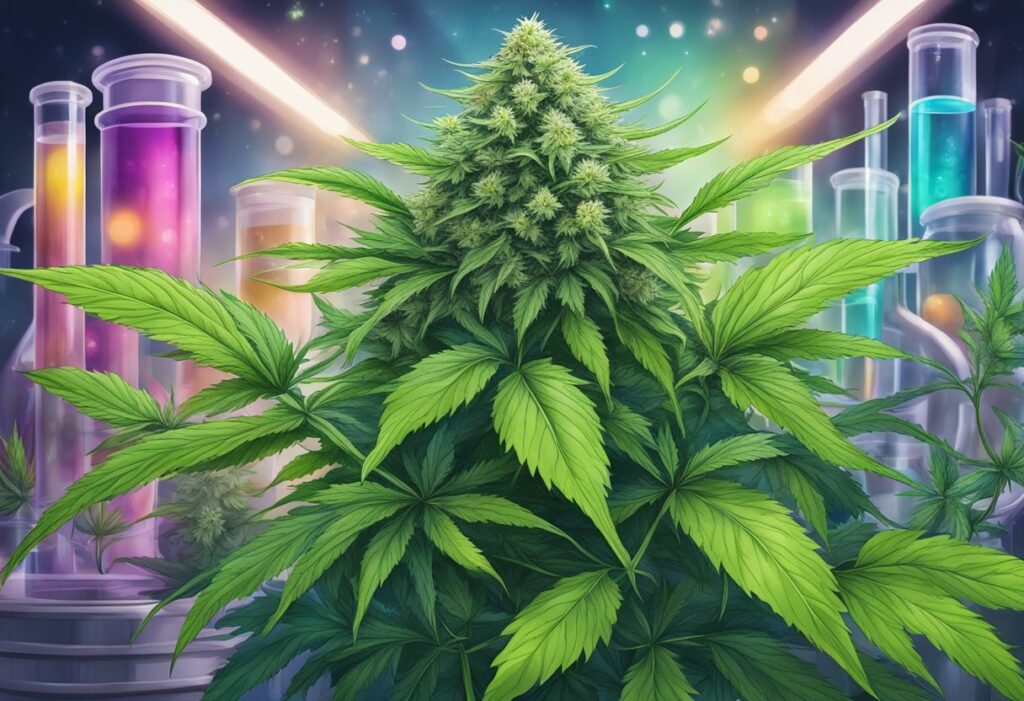Cannabinoids are a group of compounds found in cannabis plants, which include marijuana and hemp. These chemical compounds interact with receptors in the human body, specifically the endocannabinoid system (ECS), to modulate various physiological processes. The two most well-known cannabinoids are delta-9-tetrahydrocannabinol (THC), which is responsible for the psychoactive effects of cannabis, and cannabidiol (CBD), which has gained significant attention in recent years for its potential therapeutic benefits.
The endocannabinoid system plays a crucial role in maintaining balance and stability in the body. It influences diverse functions, such as mood regulation, pain perception, immune response, and sleep patterns, among others. When cannabinoids bind to the receptor sites in the ECS, they can alter the release of neurotransmitters and produce various effects, ranging from relaxation and pain relief to increased alertness or coordination impairment, depending on the specific compound and its concentration.
Key Takeaways
- Cannabinoids are chemical compounds found in cannabis plants, with THC and CBD being the most well-known.
- The endocannabinoid system plays a critical role in regulating various physiological processes within the human body.
- Cannabinoids interact with the endocannabinoid system, producing diverse effects depending on the specific compound and concentration.
Cannabinoids and the Endocannabinoid System
Overview of the Endocannabinoid System
The endocannabinoid system (ECS) is a complex cell-signaling system that plays a crucial role in maintaining the body’s physiological balance, known as homeostasis. It is composed of endocannabinoids, enzymes, and cannabinoid receptors (CB receptors), which are found throughout the body in the central nervous system, immune system, and major organs.
Roles of CB1 and CB2 Receptors
There are two primary types of cannabinoid receptors: CB1 and CB2. CB1 receptors are primarily present in the brain and central nervous system, while CB2 receptors are predominantly found in the immune system and peripheral tissues. These receptors play essential roles in regulating various physiological functions such as emotion, memory, pain, and appetite.
| Receptor Type | Location | Function |
|---|---|---|
| CB1 | Central Nervous System, brain, and some organs | Emotion, memory, motor function, appetite |
| CB2 | Immune System and Peripheral Tissues | Inflammation, immune response, pain perception |
Endocannabinoids
Endocannabinoids are naturally occurring compounds in the body that act on cannabinoid receptors. The primary endocannabinoids are anandamide and 2-arachidonoylglycerol (2-AG). These compounds function as neuromodulators, serving to fine-tune communication between cells. They are synthesized on demand and are rapidly broken down by enzymes after fulfilling their role.
Phytocannabinoids and Synthetic Cannabinoids
Phytocannabinoids are plant-derived compounds that mimic the effects of endocannabinoids. The most well-known phytocannabinoid is delta-9-tetrahydrocannabinol (Δ9-THC), the main psychoactive component in cannabis. Besides THC, there are over 100 other phytocannabinoids present in the cannabis plant, including cannabidiol (CBD), which has gained attention for its potential therapeutic uses.
In addition to phytocannabinoids, there are also synthetic cannabinoids. These compounds are created in laboratories and designed to bind to cannabinoid receptors. Some synthetic cannabinoids are used for research purposes, while others are used as active ingredients in pharmaceutical products, such as Dronabinol and Nabilone.
The endocannabinoid system’s complexity and its role in regulating critical physiological functions make it a promising therapeutic target. Understanding the roles of cannabinoid receptors and the interactions between endocannabinoids, phytocannabinoids, and synthetic cannabinoids provides valuable insights into the potential benefits and risks of cannabinoid-based treatments.

Major Cannabinoids and Their Effects
Tetrahydrocannabinol (THC)
Tetrahydrocannabinol (THC) is the primary psychoactive compound found in cannabis. It is responsible for the well-known “high” associated with marijuana use. THC binds to cannabinoid receptors in the brain, particularly the CB1 receptors, leading to various effects such as euphoria, relaxation, and increased appetite. Some studies have suggested that THC may have potential for treatment of certain medical conditions, including chronic pain, nausea, and sleep disorders.
THC can also cause unwanted side effects such as increased heart rate, anxiety, and impaired memory and cognitive function. It’s essential to use THC-based products responsibly and under medical supervision when treating specific conditions.
Cannabidiol (CBD)
Cannabidiol (CBD) is the second most abundant cannabinoid in cannabis. Unlike THC, CBD is not psychoactive and does not cause the “high” feeling. CBD has become famous for its potential therapeutic applications, as it can modulate the effects of THC on the brain by interacting with the CB1 and CB2 receptors.
CBD has been studied for various conditions, including:
- Pain management
- Anxiety and depression
- Inflammation
- Epilepsy and seizures
- Neurodegenerative disorders
It’s important to note that more research is needed to fully understand CBD’s effects and potential applications. However, CBD-based products have minimal side effects, making them an attractive option for people seeking relief from certain symptoms.
Minor Cannabinoids
Besides THC and CBD, there are several minor cannabinoids found in cannabis, such as THCA, CBN, CBG, CBDA, and THCV. These cannabinoids are present in low concentrations in the plant and have not been as extensively studied as THC and CBD. However, they may also offer potential therapeutic benefits.
- THCA (Tetrahydrocannabinolic Acid): The precursor to THC, THCA is non-psychoactive and has been researched for its potential anti-inflammatory and neuroprotective properties.
- CBN (Cannabinol): A degradation product of THC, CBN has been investigated for its possible sedative effects and potential treatment for sleep disorders.
- CBG (Cannabigerol): A non-psychoactive compound, CBG has been studied for its potential anti-inflammatory, antibacterial, and appetite-stimulating properties.
- CBDA (Cannabidiolic Acid): The precursor to CBD, CBDA has been researched for its potential anti-inflammatory and anti-emetic effects.
- THCV (Tetrahydrocannabivarin): A compound structurally similar to THC but with different effects, THCV has been studied for its potential appetite-suppression and anti-epileptic properties.
These minor cannabinoids hold promise for further research and possible development into targeted treatments for a wide range of conditions. However, more scientific investigation is needed before their full potential can be realized.
Cannabis Plant Varieties
Cannabis Sativa
Cannabis Sativa is a tall, slender plant with long, narrow leaves. It is often cultivated for its psychoactive effects, as it contains higher levels of THC compared to other cannabis varieties. Sativa strains tend to provide an uplifting, energetic, and cerebral effect. They are commonly used for daytime relief from fatigue, depression, and anxiety. Sativas originate from equatorial regions, adapting to their environment with a longer flowering period to benefit from constant sunlight.
Cannabis Indica
Contrasting with Sativa, Cannabis Indica is characterized by its short, bushy appearance and broad, dark-green leaves. Indica varieties are known for their higher CBD content that balances their THC levels. Indicas tend to result in a more relaxing, sedative effect, making them suitable for evening use and relief from chronic pain, insomnia, and muscle spasms. These plants originated from regions with harsh climates, such as the Hindu Kush mountains, and have adapted with a shorter flowering period.
Hemp
Hemp is a variety of the Cannabis Sativa plant, cultivated primarily for industrial and non-psychoactive purposes. Unlike other cannabis varieties, hemp contains only trace amounts of THC, generally less than 0.3%, and is rich in CBD. Due to its low THC levels, hemp does not produce psychoactive effects, making it an attractive option for CBD-based products, textiles, building materials, and more. Hemp’s versatility makes it a popular crop in agriculture, with some varieties even used as a sustainable alternative to traditional fibers and materials.
Clinical Applications of Cannabinoids
Cannabinoids, the active compounds found in cannabis, have been increasingly studied for their potential therapeutic applications. In this section, we will discuss their uses in pain management, cancer treatment, epilepsy, multiple sclerosis, and AIDS-related weight management.
Pain Management
Cannabinoids have shown promise in the treatment of various types of pain, including chronic pain and neuropathic pain. They are thought to work by modulating the pain signals in the nervous system. For example, in a study conducted on the use of cannabinoids for pain, researchers found that although randomized controlled trials were inconclusive, open-label or retrospective reports showed promising results in reducing pain.
Cancer and Chemotherapy-Induced Nausea
Cannabinoids have demonstrated effectiveness in controlling chemotherapy-induced nausea and vomiting in some cancer patients. They are considered an alternative to traditional antiemetic medications, especially when patients do not respond well to other treatments. Some studies like this review on cannabinoids in cell death have also highlighted the potential role of cannabinoids in cancer therapies and their ability to modulate cell death. However, more research is needed to establish their efficacy as a cancer treatment.
Epilepsy and Multiple Sclerosis
Cannabinoids, particularly cannabidiol (CBD), have shown promise in treating certain types of epilepsy, such as Dravet syndrome and Lennox-Gastaut syndrome. The FDA has even approved a CBD-based medication to treat these conditions.
In the case of multiple sclerosis, cannabinoids have been found to help with muscle spasticity and pain. Some clinical trials have been conducted to determine the efficacy of natural cannabinoids for the treatment of symptoms associated with multiple sclerosis.
AIDS and Weight Management
Cannabinoids, due to their appetite-stimulating properties, have been prescribed for patients suffering from AIDS, where weight loss and lack of appetite are common issues. In these cases, cannabinoids can help maintain weight and improve overall quality of life for patients. A review on the clinical use of cannabinoids mentions that CB1 receptor agonists are already being used clinically as appetite stimulants in the treatment of AIDS.
Cannabinoids have a wide range of potential medical applications, including pain management, cancer treatment, epilepsy, multiple sclerosis, and AIDS-related weight management. However, more research and clinical trials are still needed to fully understand their efficacy and safety.
Consumption Methods and Products
Smoking and Vaping
Smoking and vaping are popular methods for consuming cannabinoids, such as THC and CBD. These methods involve the inhalation of cannabinoids in the form of smoke or vapor. Traditional smoking methods include using pipes, joints, and blunts. In recent years, vaping has gained popularity as a potentially safer alternative to smoking. Vaping devices include vape pens and vaporizers that heat cannabis oils or dry herbs to release cannabinoid-rich vapor.
Edibles and Oils
Edibles are another widely used method for consuming cannabinoids. These are food products infused with cannabinoids like THC or CBD. Common edibles include gummies, brownies, and chocolates. Edibles offer a subtle and discreet way to consume cannabinoids, but the effects take longer to onset compared to smoking or vaping.
Cannabinoid-infused oils can be ingested directly or used as an ingredient in edibles. The two main types of cannabinoid oils are:
- CBD oil: made from high-CBD, low-THC hemp, and often used for its therapeutic benefits.
- THC oil: extracted from marijuana plants with higher THC content, and commonly used for recreational purposes.
Topicals and Transdermal
Topicals are creams or lotions infused with cannabinoids that are applied directly to the skin for localized relief. They are commonly used for targeting specific areas of discomfort or inflammation and do not produce the psychoactive effects associated with THC consumption.
Transdermal patches are another option for those seeking targeted cannabinoid delivery. These adhesive patches release cannabinoids slowly through the skin and into the bloodstream. Transdermal patches are favored for their discrete and controlled release, providing a consistent dose of cannabinoids over time.
Various consumption methods and products offer different experiences and benefits for cannabinoid use. From smoking and vaping to edibles and topicals, the choice of method ultimately depends on personal preference, desired effects, and individual needs.
Regulatory Status and Considerations
United States Federal and State Laws
In the United States, the regulatory status of cannabinoids, particularly CBD, is complex and varies between federal and state laws. According to the 2018 Farm Bill, hemp-derived CBD with a THC concentration of no more than 0.3% is considered legal at the federal level. However, state-level regulations may differ, with some states allowing, restricting, or completely banning the production, sale, and use of certain cannabinoids.
The Controlled Substances Act (CSA) classifies marijuana as a Schedule I substance, meaning its use for any purpose is federally illegal. However, various states have legalized medical marijuana to varying degrees, and some states have also decriminalized or legalized recreational use, leading to a complex relationship between federal enforcement and state regulations.
Food and Drug Administration (FDA) Approvals
The Food and Drug Administration (FDA) has approved several cannabinoid-based medications for specific medical conditions. The most notable example is Epidiolex, a CBD-based drug approved in 2018 for the treatment of certain severe forms of epilepsy. Additionally, the FDA has approved medications containing synthetic cannabinoids, such as dronabinol (Marinol and Syndros) and nabilone (Cesamet), which are used to treat nausea and vomiting associated with chemotherapy, as well as anorexia in patients with AIDS.
However, it is essential to note that the FDA does not currently approve or regulate non-prescription CBD products, which are widely available in the United States. Therefore, the quality, safety, and efficacy of these products is not guaranteed, and consumers must exercise caution when purchasing and using them.
Medical Marijuana Programs
Various states have established medical marijuana programs to provide access to cannabinoids for patients suffering from specific health conditions. These programs typically require patients to obtain a recommendation from a qualified healthcare provider and register for a medical marijuana card with the state. Eligible conditions for medical marijuana use may include cancer, epilepsy, multiple sclerosis, chronic pain, HIV/AIDS, and others. Each state has its guidelines for growing, distributing, and using medical marijuana, contributing to the complex and fragmented regulatory landscape in the United States for cannabinoids.
Potential Risks and Side Effects
Short-Term Side Effects
Cannabinoids, such as those found in cannabis and medical marijuana products, can cause various short-term side effects. Some common side effects include dry mouth, dizziness, red eyes, short-term memory impairment, and increased appetite. Additionally, it has been reported that high doses may lead to anxiety and paranoia in some individuals. It is important to note that these effects tend to be temporary and can vary depending on the individual and the specific cannabinoid consumed.
Long-Term Health Implications
Long-term use of cannabinoids has been associated with several potential health implications. Regular use may increase the risk of respiratory issues, especially for those who smoke cannabis. Additionally, there is evidence suggesting that long-term use may have negative effects on mental health, such as an increased risk of developing psychiatric disorders like depression and anxiety disorders. However, more research is needed to establish the extent of these risks and their causal links to cannabinoids.
Addiction and Dependence
While cannabinoids generally have a lower risk of addiction compared to other substances, some individuals may still develop a dependence on them. This can lead to withdrawal symptoms, such as irritability, insomnia, and appetite changes when attempting to quit. The risk of developing dependence is higher for those who start using cannabinoids at a young age and in individuals with a history of substance use disorders.
Interactions with Medications
Cannabinoids can interact with a variety of medications, leading to potentially serious side effects. For instance, they can inhibit certain liver enzymes, thereby affecting the metabolism of other drugs. Some common medications that can be affected include warfarin, theophylline, and clobazam. It is crucial for individuals using cannabinoids for medical purposes to consult with their healthcare provider to discuss potential drug interactions and the appropriate dosage adjustments.
Research, Pharmacology, and Future Directions
Pharmacological Properties of Cannabinoids
Cannabinoids are a diverse group of compounds that interact with the endocannabinoid system, which plays a crucial role in regulating various physiological processes. The two primary cannabinoids found in the Cannabis plant are tetrahydrocannabinol (THC) and cannabidiol (CBD). THC is primarily responsible for the psychoactive effects of cannabis, while CBD has numerous non-psychoactive effects and potential therapeutic applications. Cannabinoids have been studied for their potential anti-inflammatory, analgesic, and anti-cancer properties.
Current Research and Clinical Trials
Researchers continue to explore the potential therapeutic applications of cannabinoids, particularly in the treatment of chronic pain, epilepsy, and psychiatric conditions. One promising area of research is the use of cannabinoids for cancer treatment, where they have demonstrated the potential to inhibit tumor growth and metastasis. Additionally, recent studies suggest that cannabinoids may be effective analgesic agents, offering a possible alternative to traditional opioid painkillers.
Some clinical trials have been conducted to further evaluate the efficacy of cannabinoids as therapeutic agents. For example, numerous studies focus on evaluating the potential benefits of CBD in treating epilepsy, particularly in cases where traditional pharmaceutical treatments have proven ineffective.

Emerging Cannabinoids and Potential Uses
Aside from THC and CBD, other lesser-known cannabinoids are being investigated for their potential therapeutic applications. These emerging cannabinoids include cannabigerol (CBG), cannabinol (CBN), and cannabichromene (CBC). Researchers are examining their potential in treating various conditions, such as inflammation, neurodegenerative diseases, and mood disorders.
Some studies suggest that combining multiple cannabinoids, a concept known as the “entourage effect,” may enhance their overall therapeutic effects. This approach may lead to the development of more effective cannabinoid-based medications in the future.
Cannabinoids represent a promising area of research with a wide range of potential therapeutic applications. As more studies are conducted and a better understanding of their pharmacological properties is developed, new and more effective cannabinoid-based therapies will likely emerge.
Frequently Asked Questions
What is the function of endocannabinoids in the human body?
Endocannabinoids play a crucial role in maintaining the body’s homeostasis. They are part of the endocannabinoid system, which consists of receptors, enzymes, and other molecular components. This system is involved in regulating various functions such as pain, mood, stress response, appetite, and immune activity.
Can you list the potential health benefits of cannabinoids?
Cannabinoids, such as CBD and THC, have a range of potential health benefits. Some studies have suggested they may help reduce inflammation, control seizures, treat chronic pain, and even combat anxiety and depression. Cannabinoids can potentially benefit individuals suffering from conditions like multiple sclerosis, epilepsy, and cancer.
How do different cannabinoids interact with receptors in the brain?
Cannabinoids interact with specific receptors, mainly CB1 and CB2, present in the brain and throughout the body. THC, the primary psychoactive component of cannabis, binds to CB1 receptors, resulting in the well-known “high.” On the other hand, CBD has a weaker affinity towards receptors, making it non-intoxicating but capable of modulating the actions of other cannabinoids.
What are the primary side effects associated with cannabinoid use?
Although cannabinoids have potential therapeutic properties, some side effects might arise from their use. Common side effects include dizziness, dry mouth, nausea, increased heart rate, and changes in appetite. Additionally, high doses of THC can cause anxiety and paranoia in some individuals.
What is the structural composition of cannabinoids?
Cannabinoids are a group of chemical compounds with a similar structure. They consist of a core structure of 21 carbon atoms arranged in a unique three-ring system. The basic structure can be modified in various ways, giving rise to a wide range of cannabinoids with different properties and effects.
How many types of cannabinoids exist and can you give some examples?
There are over 100 known cannabinoids present in the cannabis plant. The most well-known cannabinoids are:
- THC (tetrahydrocannabinol) – the primary psychoactive compound responsible for the “high” associated with cannabis use
- CBD (cannabidiol) – a non-intoxicating cannabinoid with potential therapeutic benefits
- CBG (cannabigerol) – a minor cannabinoid with potential anti-inflammatory and neuroprotective properties
- CBC (cannabichromene) – a non-psychoactive cannabinoid thought to have potential anti-inflammatory and anti-fungal properties
Sources
- https://www.sciencedirect.com/science/article/pii/S0091305720303142
- https://www.liebertpub.com/doi/abs/10.1089/can.2018.0030
- https://academic.oup.com/jncimono/article-abstract/2021/58/114/6446199
- https://www.tandfonline.com/doi/abs/10.1080/19390211.2020.1796886
- https://www.fda.gov/consumers/consumer-updates/what-you-need-know-and-what-were-working-find-out-about-products-containing-cannabis-or-cannabis
- https://www.liebertpub.com/doi/full/10.1089/can.2019.0045
- https://www.safeaccessnow.org/state_and_federal_law
Last Updated on December 19, 2023 by Megan Mbengue, BSN, RN, CHPN


